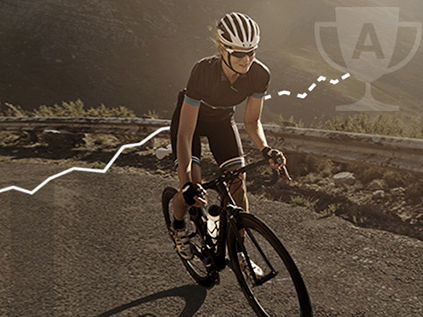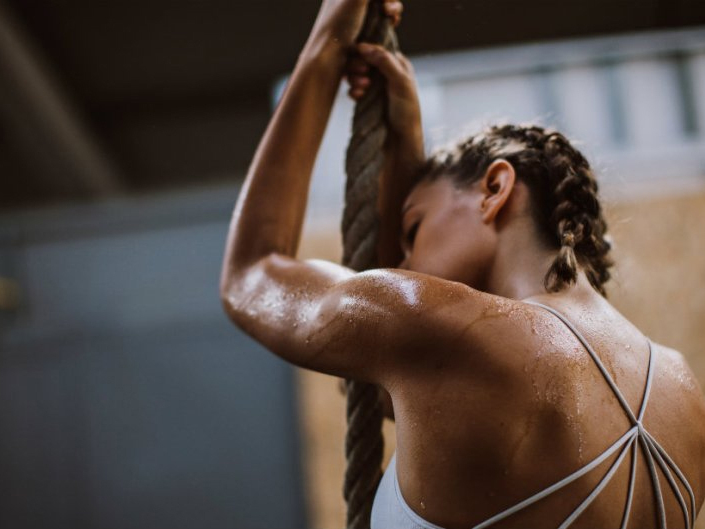Home Bike Studio Setup
Put together your Home Bike Studio
Set up in an area with enough space for your bike, with plenty of room and free of any potential obstacles.
Set up in an area with enough space for your bike, with plenty of room and free of any potential obstacles.
The area should have good ventilation and a cool temperature. A spare room, garage, and/or basement are popular options.

Equipment Needed:
Equipment Needed:
Smart Trainer, Aluminum Rollers, Rubber Mat, Climbing Front Wheel Block
Smart Trainer, Aluminum Rollers, Rubber Mat, Climbing Front Wheel Block
Other Equipment Needed
Entertainment: TV, Radio, Computer, etc.
Entertainment: TV, Radio, Computer, etc.
Fan: 20”, Centrifugal, AC Unit, Towel
Fan: 20”, Centrifugal, AC Unit, Towel
Software Platforms:
- Zwift
- TrainerRoad
- Rouvy
- 3rd party turbo app (Wahoo app for example)

Race Day Check-List
Race Day Check List
Pack these items the night before the race. You may not use everything, but you will be prepared for anything.


Clothing
Start from your feet and work your way up
- Socks
- Shoes
- Shoe bag
- Tights
- Knee warmers
- Leg warmers
- Shorts
- Base layer or under shirt
- Jersey
- Arm Warmers
- Jacket
- Rain jacket
- Gloves (Long finger, Short finger)
- Hat
- Helmet
- Sunglasses (different color lenses)
- Accessories bag
- Duffel bag
Food and Energy Supplements
- Bars
- Energy drink mix
- Gels
- Musette bag
- Recovery drink mix
- Water bottles




Leg Creams
Keep everything in a small separate bag
- Cream/heat ointment
- Rubbing alcohol
- Towel (hand, full)
- Vaseline
Tools
- Chain lubricant
- Cogs, spare
- Crescent wrench
- Duffel bag, extra
- Inner tube
- Multi-hex wrench tool
- Pump
- Screw drivers
- Tire levers
- Wheels, spare




Post Race Bag
- Change of clothes
- Flip Flops/Sandales
- Towel
- Body/Baby wipes
- Water bottle
- Deodorant
- Toothbrush and paste
Miscellaneous
- Bike
- Heart rate strap
- Computer head unit and charger
- Drivetrain batteries and charger
- Sunscreen
- Chamois cream
- Entry form
- First-aid kit
- Number (if issued)
- Race information (course details)
- Racing license
- Safety pins


Dental Care
Dental Care
Several studies have shown good health starts with your teeth. In order to perform at your best, athletes must remain fit and healthy.
For dental health, follow a generally healthy diet low in additives and sugars. (While training, racing and competing, consume simple sugars.) Your diet should consist of fruits and vegetables as well as appropriate ratios of protein, carbohydrate, and fats. Try to consume low amounts of alcohol, which is high in calories and can be high in sugars.


Practice good dental care with the following:
- Visiting the dentist/dental hygienist twice a year
- Brushing your teeth twice a day (typically right after meals)
- Rinsing with a fluoride mouthwash 2-4 times a day
- Flossing Daily
- Brushing soon after a competition or training exercise, especially when you ingested glucose drinks, gels, or bars
Daily Routine
Daily Routines
Building High Performance Habits
Create the daily routines that lead to optimized athlete health
Following a daily routine can help you establish priorities, limit procrastination, keep track of goals, and even make you healthier.


Working Day
For athletes working a conventional 9-5, try to adhere to the following schedule to balance training, work, recovery, and free time.
Here is an example of a daily structure when work is the main objective of the schedule. The chart shows examples of 1 or 2 workouts within the day.
Non-Working Day
If you have the day off from work, it is best to maintain a regimented sleep/wake cycle to sync circadian rhythms and consistent training loads.
Here is an example of a daily structure when training is the main objective of the schedule. The chart shows examples of 1 or 2 workouts within the day.


Keys to Training
Keys to Proper Training
10 key guidelines to insure optimal athletic performance


Choose goals and train toward accomplishing objectives
Striving toward a goal will heighten your focus and aid training completion
Train consistently and moderately
Steady increases and consistent efforts are the keys to proper training




Rest and Recovery is vital
Recovery is essential for allowing you to train and compete at your best
Follow an organized plan
A well thought-out and chronicled plan is needed to achieve your goals




Train hard on hard days and train easy on easy days
Follow your plan so that you can complete prescribed training workouts
Ease back on your training before losing fitness
Knowing when to say when is crucial not over fatiguing yourself




Listen to your body
Less is more when training. Do one less interval more often than one more interval.
Improve your weaknesses
Your training plan must be well-rounded to ensure you achieve the most you can out of your athletic potential.




Group training is only one training exercise
Make sure to use group training when needed, but not as a habit. It will be in a training program as a workout protocol, not as the bulk of the training plan.
Trust your training
Stick to the plan. Focus on yourself, your goals and your training. Ignore what other athletes are doing.


Race Bag
Race Bag
Packing a race bag helps prepare you for all racing situations.
Organize a race bag that has everything you need in a way so you can easily access items.
Below is a list of what items you should have and how to section the items within the race bag. Use large Zip-Lock or nylon bags to organize items within the larger race bag.


Large Race Bag
Duffle style with multiple compartments
Place the following all in their separate bags
- Jersey
- Shorts
- Socks
- Shoes
- Base Layers
- Jacket, Vest, Raincoat
- Warmers (arm/knee/leg)
- Over-shoes
- Hats
- Gloves, (winter gloves)
- Helmet
- Sunglasses
- Heart rate strap
- Computer head unit and charger
- Chamois cream
- Hot ointments and creams
- Sunscreen
- Safety Kit
- Gels, Bars
- Water Bottles
- Drink Mix
- Safety Pins
- Towel
Clothing Guide
Clothing Guide
The weather will determine what clothing will be needed to complete training.
Make sure to choose sports clothing that is breathable, can easily be layered and compact to place into a jersey pocket when not needed.


Annual Goals
Annual Goals
If you don’t know where you want to go, you are never going to find a way to get there. Written annual goals help guide and focus training.


Primary Priority Goals
Start with your primary priority goals which will be your peak season goals. It is only possible to prepare for priority goals two or three times per year r, so choose wisely and pick events that are about three to four months apart.
Secondary Goals
Next choose your secondary goals. These are goals raced shortly before or after your primary priority goals, but yearly training does not revolve around them. Choose about 5 of these goals but pick times in the year when you will be close to achieving top fitness.




Tertiary Goals
The rest of your race calendar will include tertiary events and should be chosen as events you enjoyor that will be a stepping stone to reaching your goals. You can compete in as many of these as you would like. Some of these events will be used as training, practice events, or early success goals.
With your outlined goals chosen, we will begin developing a training plan which will be the means with which we will achieve your goals.


Health Guide
Health Guide
Athletes are extremely active people who are only slowed down by illnesses. In this guide, the following measures and tips will help avoid illness.


Professional Guidance
- Doctor Visits: Full physical, including standard check-up, blood work and ECG, once a year in the off season with an optional second mid-season check-up.
- Dental Visits: Dental cleaning every six months with additional x-rays once a year
- Chiropractic Visits: Visits every week to two weeks with a sport chiropractor
- Orthopedic Care Visits: With any joint, bone or muscle pain, visit an orthopedic doctor to discuss treatment visits when needed.
Over-the-counter Medications
- Advil: muscle soreness and fever
- Vicks Vapor Rub: apply to chest and nose
Visit a doctor for guidance on when to take prescription medication.




Preventative Alternative Medicines
Two main obstacles with using over-the-counter or prescription medicines
- USADA-allowed medications guidelines, which include some surprising items.
- Prolonged recovery
Natural Remedies
Two main obstacles with using over-the-counter or prescription medicines
- Green Tea: Naturally Low caffeinated tea with lots of anti-oxidants to fight off free radicals helping immune system strength. It is a good replacement for coffee in the morning and an afternoon appetite suppressant.
- Echinacea Extract: When resting heart rate is unusually high and you feel a cold might be coming on, use Echinacea extract to build up your immune system and to help decrease chances of catching a cold.
- Oregano Oil: For a sore throat use Oregano oil in a droplet form. Place some under your tongue for 30 seconds and discard. Then rub some on the back of your gums.
- Zinc Defense Lozenge: When you feel a cold or sore throat coming on, start taking the lozenge multiple times per day up to 5 days in duration.
- Fresh Garlic: Ingest a fresh clove of garlic when you feel sick to kill bacteria in your mouth and digestive tract.
- Sinus Drip: In a water bottle with room temperature water, mix in a half teaspoon of table or sea salt. Over a sink, place the spout of the water bottle in one nostril and and slowly pour the water up and through the sinus cavity and out the other side. After water is flowing smoothly do the same to the other nostril.
- Inhale Steam: Bring water to a boil in a pot then lower the heat. Place a towel over your head then lean over the pot to breath in the steam.


Complete Athlete
Complete Athlete
What does it take to become an athlete?
It takes a multitude of details and consistency to achieve full athletic potential.











